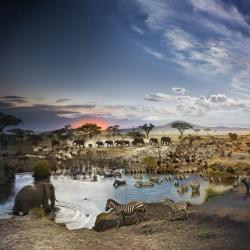
The new National Geographic exhibition for the Explore cycle, which will be on show at Palazzo Blu in Pisa from 7 April to 25 June, is about to start. After On the Moon and Beyond and Oceans, the Last Frontier, the third project is Explore. Planet Earth, curated by Marco Cattaneo, director of National Geographic Italia.
The exhibition will revolve around the exploration of the Earth, what we have discovered about our planet, the variety of animals that inhabit it, ecosystems and the impact of mankind on the health of the environment. The aim is to depict the history of the Earth and its transformations, to tell the story of the extraordinary diversity of the world around us and its vulnerability. The Earth has become the planet of man, who has colonised every corner of it, shaping it in his image and likeness. We have learnt to know every aspect of it and to exploit its resources. Today, however, with 8 billion human beings, man's impact on the planet is disruptive. Every year, more renewable resources are consumed than the Earth can produce. Every year, natural habitats are reduced due to the need for agricultural land, raw materials and energy. All this comes at a price, which is too high today. So we must find more environmentally friendly solutions if we want to hand over to future generations a planet that can still offer resources and opportunities.
The exhibition begins with photographs of day-to-night work by Stephen Wilkes, in which different subjects are filmed from the same position for thousands of shots over a 24-hour period. It continues with images of natural environments, from the Grand Canyon to the Serengeti, and images of human or man-made environments, from New York to the endless tulip fields in Holland. It continues with the geological history of the planet and what the layers that emerge here and there from the folds of the Earth tell us, from fossils to the slow evolution of life. This exhibition is an opportunity to take visitors to the most unique and fascinating environments on the planet, from the most torrid deserts to the most inextricable forests. But also to witness the majestic spectacle of nature in its extreme beauty as well as in the terrifying power of its most violent events. Animals and their evolution are an important part of the journey. From those we all love, to the most singular and vulnerable ones, which are disappearing with the sixth great extinction. A section of the exhibition is devoted precisely to extinctions, in a palaeontological key with material finds and in a modern key, through images and with examples of recent extinctions, in which we are sure there is a human hand. In the exhibition we meet the ancestors - Neanderthal, Denisova - and the stages of human culture, from Göbekli Tepe to Stonehenge. But also endless metropolises, cathedrals in the desert, abandoned places, felled forests, mines and landfills. To touch the impact of man on the planet, the savage exploitation of resources, the devastation of entire regions. The exhibition ends with a positive message. A series of images that tell of the tools we can, or rather must, use to restore a healthy relationship with the environment, to hand on to future generations a world that is no longer on the brink of the precipice.
For more information on National Geographic exhibitions visit natgeo.org/exhibitions.
For more information https://palazzoblu.it/mostra/explore-pianeta-terra/
Photo: Serengeti National Park, Tanzania, Day to Night™, 2015 © Stephen Wilkes